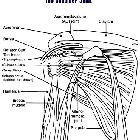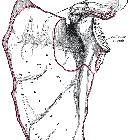Supraspinatus tendon




The supraspinatus muscle is one of the four muscles that make up the rotator cuff, the others being: infraspinatus, teres minor, and subscapularis.
Summary
- origin: supraspinous fossa of the scapula
- insertion: superior facet of the greater tubercle of the humerus
- innervation: suprascapular nerve (C5,6)
- arterial supply: suprascapular and dorsal scapular arteries
- action: abduction of the humerus
Gross anatomy
Origin
The supraspinatus muscle arises from the supraspinous fossa, a shallow depression in the body of the scapula above its spine. The supraspinatus muscle tendon passes laterally beneath the cover of the acromion.
Insertion
The supraspinatus tendon is inserted into the superior facet of the greater tubercle of the humerus. The distal attachments of the three rotator cuff muscles that insert into the greater tubercle of the humerus can be abbreviated as SIT when viewed from superior to inferior (Supraspinatus, Infraspinatus, and Teres minor).
Innervation
The supraspinatus muscle is supplied by the suprascapular nerve (C5 and C6), which arises from the superior trunk of the brachial plexus, passes laterally through the posterior triangle of the neck and through the scapular notch on the superior border of the scapula. After supplying fibers to the supraspinatus muscle, it supplies articular branches to the capsule of the shoulder joint.
This nerve can be damaged along its course in fractures of the overlying clavicle, which can reduce the person’s ability to initiate the abduction.
Action
Contraction of the supraspinatus muscle leads to abduction of the arm at the shoulder joint. It is the main agonist muscle for this movement during the first 15 degrees of its arc. Beyond 15 degrees the deltoid muscle becomes increasingly more effective at abducting the arm and becomes the main propagator of this action.
The supraspinatus muscle is one of the musculotendinous support structures called the rotator cuff that surrounds and enclose the shoulder. It helps to resist the inferior gravitational forces placed across the shoulder joint due to the downward pull from the weight of the upper limb.
The supraspinatus also helps to stabilize the shoulder joint by keeping the head of the humerus firmly pressed medially against the glenoid fossa of the scapula.
Related pathology
The supraspinatus muscle tendon is often ruptured in sports involving sudden forceful movements of the upper limb and is the most commonly ruptured rotator cuff muscle. The muscle can also degenerate in the elderly leading to increased instability and loss of function at the shoulder joint.
The supraspinatus tendon can also become inflamed, in persons of any age, leading to supraspinatus tendinitis which is often associated with shoulder impingement syndrome.
Siehe auch:
- Bursa
- Bursa subacromialis
- Musculus teres minor
- Rotatorenmanschette
- Musculus infraspinatus
- Schulter Anatomie
- Musculus subscapularis
- Impingement der Schulter
und weiter:
- Klassifikation der Akromiontypen nach Bigliani
- posterosuperior impingement of the shoulder
- Impingement
- Oberarmmuskulatur
- Schultermuskulatur
- Schultersonographie
- rotator cuff interval
- magic angle effect
- Schultergelenksmuskulatur
- Nervus suprascapularis
- Tuberculum majus Ansatz
- suprascapular neuropathy due to a spinoglenoid notch ganglion
- subakromiales Impingement
- subcoracoidales Impingement

 Assoziationen und Differentialdiagnosen zu Musculus supraspinatus:
Assoziationen und Differentialdiagnosen zu Musculus supraspinatus:






